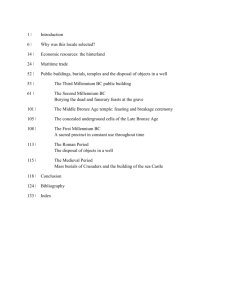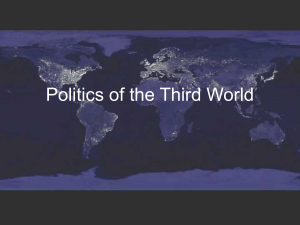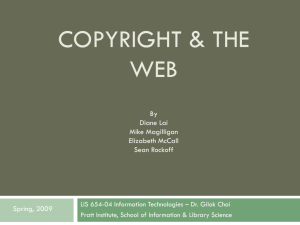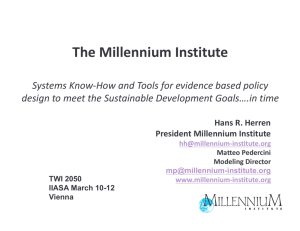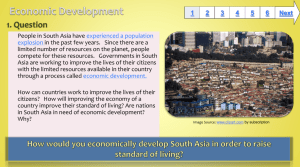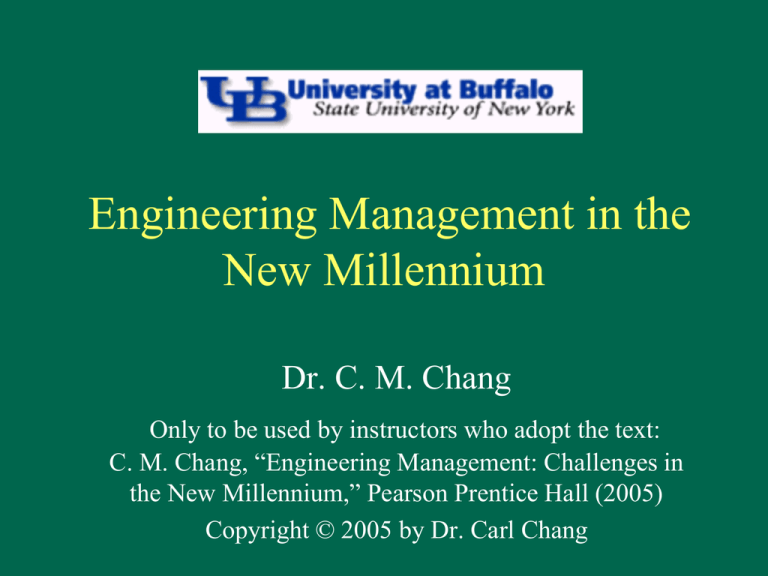
Engineering Management in the
New Millennium
Dr. C. M. Chang
Only to be used by instructors who adopt the text:
C. M. Chang, “Engineering Management: Challenges in
the New Millennium,” Pearson Prentice Hall (2005)
Copyright © 2005 by Dr. Carl Chang
Approaching the New
Millennium
• Emerging Future Trends
• Differences in Companies in New and Old
Economies
• Characteristics of New Era Companies and
Strategies in Production, Distribution and Service
• Transition to the Knowledge Economy - Examples
• Personal Strategies for the Future
• Contributions in the New Millennium
• The Challenges Ahead
2
Emerging Future Trends
3
Emerging Future Trends
4
(A) Customer Focus
• Process (speed, transparency, self-help)
• Customer service (quality/reliability - Service
Profit Chain Model)
Leadership
Good Place
to Work
Employee
Satisfaction
Employee
Retention
Value to
Customer
Employee
Productive
Revenue
Growth
Customer
Loyalty
Customer
Satisfaction
Profitability
5
(B) Enterprise Resource Integration
• Integrated Communications Systems Information sharing
• Wireless Applications
• Leveraged legacy systems
6
(C) Supply Strategy
• Work Outsource: Production, back-office work,
logistics, after-sales customer service, procurement,
inventory management, new product design, and
others
• Integrated parts suppliers - automobile component
firms with flexible production maintained at capacity
• Integrated service organizations – Offering
financial advisement, accounting, insurance and
banking for many firms
7
(D) Knowledge Management
• Preservation of know-how critical to
knowledge-intensive companies
• Dissemination
• Wide-spread applications to add value
• Supply chains of knowledge agents and
centers
8
(E) Organizational Changes
• Type one - Assemble and market products/
services to consumers: (1) retain core
competence and outsource others, (2) form
Supply chains, (3) focus on customer’s needs,
(4) become Virtual organizations
• Type Two - Supply specialized products/
services to client companies: (1) build flexible
production facilities (e.g., cells) to respond, (2)
vertically integrated
9
(E) Organizational Changes
(cont’d)
• Transition from One to the other - Virtual
organizations produce commodity-like
products well - When breakthrough,
leading edge performance is needed, no
perfect information exists for product
specification, virtual companies may swing
back to vertical enterprises (e.g., Cisco in
Optical Networks)
10
(F) Population Diversity
• U.S. Census Bureau Prediction (2004):
Population Composition
White (Non-Hispanics)
Black (Non-Hispanics)
Hispanics
Asian/Pacific Islander
Native Americans
•
1995
2050
73.60%
12%
10.20%
3.30%
0.70%
50.10%
14.52%
24.40%
7.86%
0.90%
Women and minority attain key positions
11
(G) Migration of White Collar
Jobs to Other Countries
• Job migration - Clerical, chip design, customer
service, software programming, tax
preparations (jobs following procedures)
• 3.4 million jobs by 2015 to low wages
countries (China, India, Ireland, The
Philippines, India, Mexico, and Russia)
• Pressure on American workers - How to justify
the high wages with the value they create?
12
(G) Job Migration to Other
Countries (cont’d)
13
(G) Job Migration (cont’d)
• (1) Caltex Petroleum - shifted service and
professional jobs from Europe and U.S. to
Ireland, Jamaica, India and the Philippines
• (2) Bell Labs has large research centers in
Bangalore and Hyderabad, India
• (3) Sun Micro-System hired Russian
scientists for software and microprocessors
research.
14
(G) Job Migration (cont’d)
• (4) Accenture (Anderson Consulting) pays
1/3 to 1/4 of US wages to Philippine workers
• (5) General Electric shifted some 1000
customer service jobs to New Delhi,
additional centers for handling payroll,
design and billing services are planned
• (6) Texas Instruments has its integrated
circuits designed in India, since 1986
15
Engineering Graduates
US Graduates as Percent of Total
(5 Countries)
Percentage
50%
40%
30%
BS
20%
MS/PhD
10%
0%
1989
1999
2009
Year
5 Countries: USA, China, India, Mexico, The Philippines
16
(H) Globalization
• Clear trend in the new Millennium (Market,
resources, technologies); most companies
will be actively involved
• United Nations Forecast: Five largest GDPbased national economies in the World by
2020: (1) China, (2) US, (3) Japan, (4)
India, (5) Indonesia
17
US Companies
18
Old Economy Companies
T
o
p
U
p
p
e
r
M
i
d
d
l
e
F
i
r
s
t
L
a
v
e
l
B
o
t
t
o
m
• Rigid hierarchies and Clear
boundaries
• Capital Intensive, fixed
tangible assets centered
• Small price/book value ratios
• Shareholders are owners
• Functions are vertically
integrated, emphasizing selfsufficiency, stability and
incremental growth
19
Old Economy Companies
(cont’d)
• Rivalries among competitors motivate
employees and drive success in marketplace
• Going concern
• Communications follow chain of command
• decision making is resources centered efficiency driven
• Slow transactional processes, with business
data available monthly
20
Knowledge Economy Companies
• Flat organization with small core and
extensive alliance/partnership networks,
with fussy company boundaries
• Idea-intensive, with digitalizable and
commodity-like goods (data, software,
entertainment, cars, computers, jeans etc.)
• Focusing on time to market, cost reduction
through technologies supplied by alliance
21
Knowledge Economy Companies
• Flat organization with small
core and extensive alliance/
partnership networks, with fussy
company boundaries
• Idea-intensive, with commoditylike and digitalizable and
commodity-like goods (data,
software, entertainment, cars,
computers, jeans etc.)
• Focusing on time to market, cost
reduction through technologies
gained from alliance
22
Knowledge Economy
Companies (cont’d)
• High market value to book value ratios
• Shareholders not solid owners, as ideas in
people’s heads can not be chained down risk factor
• Virtual organization with changing partners
• Collaborate, not competing against
competitors to achieve win-win advantages
• Some companies get acquired over time
23
Functional Integration of
Knowledge Economy Companies
• Cisco Systems -Performs all administrative
functions over the internet, owns only 2 of
34 plants, handles only 10% of orders by
hands
• Dell Computers - Has inventory for 6 days
only
• General Motors - Build-to-Order system
for cars in 10 to 12 days in the future
24
Modern Companies
25
Characteristics of Modern
Companies
• Solicit real-time customer feedback (Internetbased communications tools)
• Target market segment of one (mass
customized products/services)
• Induce customer loyalty with personalization
of customer relationship
• Create enduring relations with employees to
connect to company’s business partners
26
Characteristics of Modern
Companies (cont’d)
• Adjust to diversified employee composition
(40% of workforce on temp basis by 2010,
talented business superstars represented by
agents)
• Organize team structures to remain flexible
• Assure instant Information flow and
efficient transactions
• Do performance evaluation constantly
27
Characteristics of Modern
Companies (cont’d)
• Use advanced tools (resources planning,
enterprise integration, supply chain
management, customer relations
management, web-based transactions,) to
reduce staff and improve efficiency
• Pursue globalization proactively
28
Organizational Design of a Progressive Enterprise
Business Partners
Supply Chain Management
Investors
Employees
Human Resource
Management
Enterprise Resource Planning
and Application Integration
(Production, Engineering,
Decision Support,
Knowledge Management,
Marketing and Sales
Management, Procurement,
and Other Business
Operations)
Customer Relationship Management
Financial
Management
Public Relations
Management
Communities
Customers
29
General Electric - An Example
• Four Initiatives: (1) Globalization, (2)
Service, (3) Digitalization, (4) Six Sigma Quality Assurance
• Jack Welsh/Jeff Immelt - Continuous
mobility
• “No back office” - Digitize or outsource
those parts of businesses not touching the
customers
30
Strategies To Make Companies
Great in New Century
• Speed - Treat time to be more valuable than
money and buy for speed
• Talents - Attract, motivate, empower and
retain the very best talents, as ideas are key
assets for any companies
• Focus - Go for long-term market position and
dominance, rather quarter-to-quarter
performance improvements
31
Strategies To Make Companies
Great in New Century (cont’d)
• Customer Orientation - Follow what
customers want and create customer-driven
supply chains
• Productivity - Outsource non-core activities,
buy technologies and digitize the rest
• Operations - Streamline operations using
advanced software technologies to adapt to
changing marketing environment
32
Personal Strategies for the Future
• Get post graduate education - learn how to
read fast, digesting information efficiently,
learn quickly.
• Understand products and markets in
transition, induced by changing technologies
• Communicate well, compromise effectively
and be a master o changes
• Create/manage external business networks
33
Personal Strategies for the Future
(cont’d)
• Be familiar with capital (venture capitalists)
and financial markets (security analysts)
• Nurture leadership skills (acting like a
conductor of a symphony orchestra)
• Size technological opportunities to benefit
the company
• Stay away from non-core, standardized or
digitalizable functions
34
Conclusions
• Engineering - Technical excellence and social
compatibility in workplace are both important
• Management - Broad knowledge and interest,
managerial perspective, training (lead,
organize, plan and control) and aptitude to
manage are success factors
• Engineering Management - Insight to use
technologies for creating business benefits
35
Conclusions (cont’d)
• Knowing what to do is not enough, practice
will make it perfect
36
References
• Di Kamp, “The 21st Century Manager: Future-focused
Skills for the Next Millennium,” Kogan Page (January
1999)
• “The 21st Century Corporation,” Business Week, pp 75212 (August 28, 2000)
• Jeffrey A. Schmidt, “Corporate Excellence in the New
Millennium,” Journal of Business Strategy, p. 39
(November 1999)
• Peter Haapanieme, “Leadership in the New Economy,”
Chief Executive Journal, p. 63 (July 2000).
• Additional 29 References are cited in Curse Notes
37
Summary of the Two-Course
Sequence
•
•
•
•
•
(1) Organizing
(2) Planning
(3) Leading
(4) Controlling
(5) Engineers as
Managers/Leaders
• (6) Engineering
Management in New
Millennium
• (7) Cost Accounting
• (8) Financial Accounting
and Analysis
• (9) Managerial Finance
• (10) Marketing Management
• (11) Web-based
Management/Engineering
Enablers
• (12) Globalization
38
Manage/Lead/Act/Think
Manage/lead/act/think
Focuses
Inside
Core competencies, cost and quality control,
Production and engineering functions
Outside
Emerging technologies, supply chains,
Market orientation, customer relationship
Today
Organize, control, plan, lead
Teams and projects, do things right
Tomorrow
New projects, new core competencies, new products,
New markets, do the right things
Local
Implementation details, local adjustments
Global
Global resources, global scale and scope,
Global mindset and savvy
39
Pyramid Building
• Manage on the inside and outside, lead from
today to tomorrow, act locally and think
globally
• Two Course sequence builds individual
pyramids, which, when constantly nurtured
and reinforced brick by brick, will allow
engineers to be visible and recognized as
leaders above the crowds for a long time to
come.
40
Vision
Innovation
Customers
Value Addition,
Supply Chains Mgmt
Engineers as Leaders
(Cost Accounting - ABC,
Financial Analysis - EVA,
Marketing Mgmt, Web Enablers)
Plan, Lead, Organize and Control
(Self, Staff, Teams, Projects, Global Issues)
41
Question # 14.2
• Leading technological innovation is a major
challenges for engineering managers in the
new millennium. What are some of the
success factors for technological
innovation?
42
Question # 14.3
• The new millennium is expected to
experience continued changes in
communications technologies, business
practices, worker diversity, customer
empowerment and marketplace conditions.
Name a few leadership qualities which are
deemed essential for engineering managers
to achieve success in the new millennium.
43
Answer #14.3 (Leadership)
• L – Listening, leveraging own capabilities
and strengths
• E – Empowering, entrusting people,
enthusiasm
• A – Action driven, attitudes, accountability,
ability to motivate others
44
Leadership
• D – Determination, decisiveness in setting
directions, detail-orientation in
management approach
• E – Energy, empathy, effectiveness,
efficiency
• R – Rewarding, respecting, risk taking,
reinventing oneself
• S – Setting personal examples, servicing
people, showing missions/vision
45
Leadership
• H – Honesty, honorable objectives
• I – Innovative, integrity, interpersonal
skills, inspiring capabilities
• P – Persistence, positive outlook, proactive
communications
Sources: Dave Fleming 2002, “Leadership for a New Millennium,” Emerging
Leaders Institute; John H. Zenger and Joseph Folkman, and Joe Folkman,
2002, “the Extraordinary Leader,” McGraw Hill Education, Europe (June )
46
47
Examples of Choice-Boards
• Choice-Boards offer customization of
needed product - Allows companies to sell
first, then produce (low or no inventory and
financial costs)
• Dell Computers - Computer systems
(memory size hard-drive, modem, monitor,
keyboard, etc.)
• Levi’s - Spin Jeans (fit, style, color)
48
Examples of Choice-Boards
Choice-Boards offer customization of needed products - Allows companies
to sell first, then produce (low or no inventory and financial costs)
49
Examples of Choice-Boards
(cont’d)
• Dell Computers - Computer systems
(memory size hard-drive, modem, monitor,
keyboard, etc.)
• Levi’s - Spin Jeans (fit, style, color)
• Proctor & Gamble - Cosmetics and
perfumes (50,000 choices)
• Nike - Sneakers (features, styles and colors)
50
Examples of Choice-Boards
(cont’d)
• American Quantum Cycles - Motorcycles
(seats, handlebars, paint color)
• Napster - Downloading music to burn custom
CDs
• Mattel - My Design Barbie - build a custom
doll (hairstyle, color, complexion, eye color)
• Cisco - Custom design router, switches and
hubs using its Marketplace portal
51
Success of Digitalization
• Bank Transaction: $1.25 by bank teller, $0.54 by
phone, $0.24 by ATM, $0.02 via Internet
• Procurement (Corning): $140 for procuring parts
and supplies by people, $11.7 via Internet-based
catalog system
• Recruitment: $128 for normal human based routine,
$0.06 by digitizing the process and eliminating labor
• General Electric - $50 over the phone for customer
inquiry, $0.50 via Internet
52

